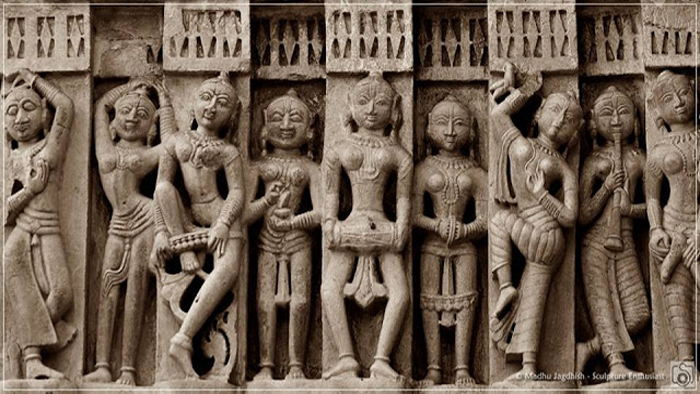Music of India: Its influence abroad

The antiquity of Indian music is beyond our racial memory. We know almost nothing of the music of the Indus Valley civilization, although it has left for us some of its musical instruments.
Primitive man did not speak, he sang like birds. According to Darwin, music has its origin in the calls of birds and animals. Narada, the exponent of the Gandharva School, agrees with this view and China provided the best example of it.
Indian music is based on melody; that of the West, on harmony. Indian dance is based on time; that of the West on space. Indian life is based on individual excellence and individual salvation; that of the West, on congregational worship and collective salvation (Western democracy based on individual freedom is a byproduct of the capitalist system. It is a travesty of the basic postulates of Western civilization.)
But to come back, the Indian civilization was the first to evolve a musical system based on the philosophic and metaphysical notions. According to the Hindu theory of music, sound (nada) appears as nada Brahma (Sound as God). Among the scared primal sounds are OM and the sound of the damaru, the drum of Shiva. Sound is a product of ether (aksa).
To the Hindus, music has a transcendental significance, music is thus scared. The flute of Krishna and the veena of Saraswati have metaphysical associations.
Indian classical music has its origin in the chanting of the Vedas. The rules of chanting (of mostly hymns of the Rig Veda) are to be found in the Sama Veda. Chanting by a single priest led to melody; by many to harmony. India has also the Gandharva (folk) and tribal traditions.

Jagdish Temple in Udaipur, Rajasthan, India
Temple is the most famous and largest temple in the city of Udaipur. Completed in the 1651 era, this temple is an epitome of bliss and stunning stone carving of Ancient Bas-relief with Apsaras.
First, there were only three notes. Later, recitations were based on seven notes. This represented the slow evolution of Indian music.
The raga-tala system is India’s unique achievement. India was the first to evolve a sol-fa system. Indian sol-fa letters (sa re ga me pa dha ni) are as old as the Upanishads. There has been no change since then. The Western sol-fa system is only a thousand years old.
Music is said to have three fundamentals: melody, harmony, and rhythm. Harmony is the basis of Western music. Chorus singing and orchestra are its most conspicuous examples. The idea of absolute music is reached in the raga. Raga is the soul of Indian music. Narada says that raga is that which pleases all living beings.
Bharata (of Natyashastra fame) classified musical instruments into four divisions: tata (stringed), avanadha (drums), ghana (solid), and sushira (wind). This classification has not been bettered by any other civilization. The West introduced this classification in 1880 only. Today India has a large variety of stringed instruments, especially the variety of veenas.
Rhythm is man’s oldest impulse. Thus, percussion instruments must be very old. No one knows how many varieties of drums there are in India. The dhundhubhi is as old as the Vedas. “There is nothing so impressive as the Indian drumming,” says an American authority on Indian music. The maddala (Tamil Nadu), mridanga, tabla, and chenda (Kerela) are the most well-known percussion instruments.
Among the wind instruments are Bansuri (flute of Krishna), nadaswaram (Tamil Nadu) and shehnai.
Between AD 1000 and AD 1400, there was a fusion of the music of the north and the Arab-Persian music. (Sunni Islam looks down upon music, but Sufis say music is a bridge to heaven). The south retained India’s music in its pure form. Amir Khusro made a major contribution to evolution of Hindustani music and musical instruments. He adapted the Persian sitar to India. The Persian gentry was in habit of giving Persian names to Indian ragas and instruments, thus creating confusion. The establishment of the 12-tone scale was a major achievement of this period.
Indian music and instruments have influenced both the East and the West. And men like Ravi Shankar have brought about a better appreciation of Indian music abroad. The Buddhists introduced many Indian musical instruments in China. The veena is pipa in China and biwa in Japan. Indian influence in Southeast Asia is more pronounced. The Persians adopted most of the Indian instruments. Dr. Lecy O’Leary admits that the Pythagorean elements in Western music can be traced to Indian sources. Alain Danilou, the great French authority on the music of East, says that Greek music, like Egyptian music, “most probably has its root in Hindu music, or, at least in that universal system of modal music, the tradition of which has been fully kept only by the Hindus.”
It is a pity that the unique and great tradition of Hindu music is being subverted by foreign popular music and by our own uprooted Westernisers. Tagore had only contempt for them. He called them ‘shadows’.
Author – M.S.N. Menon
Suggested Read: Indian Music






